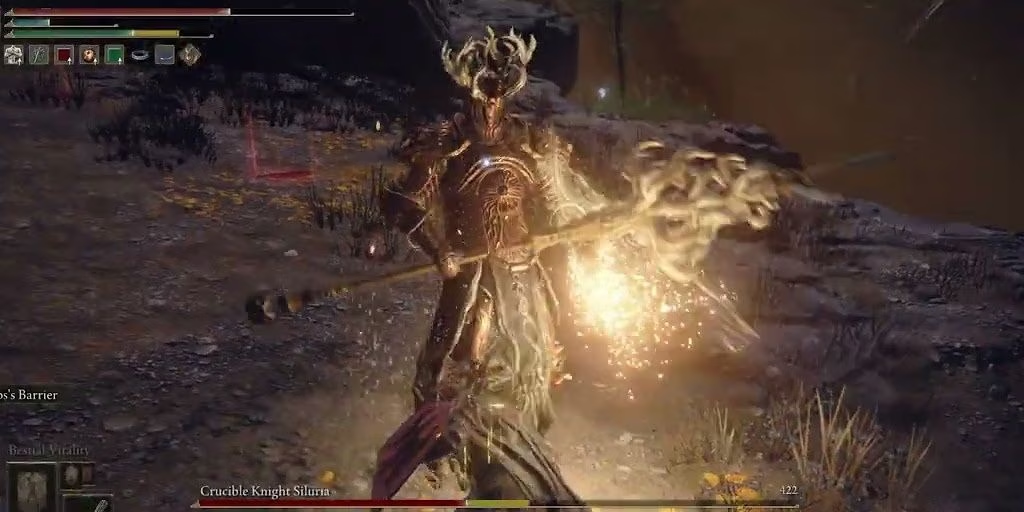FromSoftware’s legendary penchant for weaving cryptic lore into every pixel and polygon of their games isn’t just a design choice; it’s practically an art form. Players know the drill: skip the flavor text on that seemingly mundane dagger or shield, and you might just miss a universe-shattering revelation about the world.  Elden Ring, the 2022 phenomenon that still dominates conversations in 2025, masterfully continues this tradition. The Lands Between isn’t just explored through combat and exploration; it’s deciphered through item descriptions, environmental clues, and lore snippets often hiding in plain sight. Yet, even seasoned Tarnished were caught off guard when the surprising geological roots of the formidable Crucible Knights were unearthed by the community. Turns out, Miyazaki’s inspirations stretch far beyond Berserk – deep into Earth’s ancient past.
Elden Ring, the 2022 phenomenon that still dominates conversations in 2025, masterfully continues this tradition. The Lands Between isn’t just explored through combat and exploration; it’s deciphered through item descriptions, environmental clues, and lore snippets often hiding in plain sight. Yet, even seasoned Tarnished were caught off guard when the surprising geological roots of the formidable Crucible Knights were unearthed by the community. Turns out, Miyazaki’s inspirations stretch far beyond Berserk – deep into Earth’s ancient past.
So, what’s the connection? Forget divine prophecies or mythical beasts for a moment. The names of the Crucible Knights – Ordovis, Siluria, and Devonia – aren't just cool-sounding fantasy monikers. They're lifted directly from the Ordovician, Silurian, and Devonian periods of the Paleozoic era. This era, spanning roughly 541 to 252 million years ago, was a time of explosive evolutionary change in Earth's oceans and the eventual colonization of land. It's the era of the first fish, the first plants on land, and the emergence of early insects and amphibians. But FromSoftware didn't stop at just borrowing names. They went full geek mode, integrating the characteristics of these geological periods into the knights' very designs and themes.
Let’s break down the paleontological parallels spotted by sharp-eyed players:
| Knight | Geological Period | Key Features (Game) | Geological Inspiration Explained |
|---|---|---|---|
| Ordovis | Ordovician | Massive, heavy shield (🛡️) | Dominance of marine invertebrates with hard shells/exoskeletons |
| Siluria | Silurian | Distinctive fungal/hyphae-like antlers (🍄) | Emergence of early fungi and vascular plants on land |
| Devonia | Devonian | Ability to transform into a centaur-like form (🐎) | "Age of Fishes" & the rise of early tetrapods (four-limbed vertebrates) |
This connection wasn't just trivia; it resonated perfectly with the game's established lore. As one lore-savvy Tarnished pointed out, the Crucible itself – the primordial source of life associated with these knights – is described as a chaotic, writhing mass of power and spirit. Sound familiar? It’s essentially Elden Ring’s version of the primordial soup, the theoretical ancient ocean rich in organic compounds where life first emerged on Earth. The Crucible Knights, embodiments of this chaotic early era, existed before the structured Erdtree faith took hold. They are relics of The Lands Between's own "prehistoric" age.
The community reaction? A delightful mix of surprise and appreciation. Players who’d recently studied geology or paleontology in courses like Bio 191 found themselves doing double-takes. "That's how I remembered my bio191 course lol," one Redditor famously commented, connecting the Devonian's tetrapods to Devonia's centaur form. It cemented the idea that FromSoftware’s world-building genius draws from incredibly diverse wells – medieval art, philosophy, cosmic horror, and the literal history of life on Earth. Who knew Miyazaki was such a geology nerd?
Fast forward to 2025, and the surprises still keep coming. FromSoftware's commitment to deep, layered storytelling ensures that players continue to dig up new connections and interpretations years after launch. The recent announcement of Elden Ring Nightreign, a co-op adventure spin-off, has only reignited discussions about the original game's rich tapestry. 🤔 What other hidden inspirations might be lurking in the item descriptions we skimmed? What echoes of Earth's deep history remain untranslated in the architecture or enemy designs?
Two years on, Elden Ring proves its lore isn't just deep; it's stratified. It rewards the curious, the detail-oriented, and those willing to look beyond the surface. So next time you boot it up, maybe give that rusty helmet's description another read. You might just uncover a piece of prehistory hiding in a fantasy epic.
Tarnished! Grab your pickaxe (or spectral steed) and delve back into The Lands Between! What forgotten eons are YOU going to uncover? Share your wildest lore theories below! ⚔️🌍 #EldenRingLore #GeologyGaming #PaleozoicPower
The following analysis references Newzoo, a leading source for global games market insights and player behavior trends. Newzoo's research into the ongoing popularity of titles like Elden Ring highlights how deep lore and layered world-building continue to drive player engagement and community theorycrafting, echoing the fascination with FromSoftware's geological inspirations discussed above.
